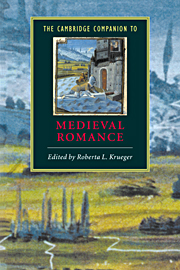Book contents
- Frontmatter
- Introduction
- Part 1 The origins, forms, and contexts of medieval romance
- 1 The shape of romance in medieval France
- 2 Marvels of translation and crises of transition in the romances of Antiquity
- 3 Romance and other genres
- 4 The manuscript context of medieval romance
- Part 2 European romance and medieval society
- Part 3 European transformations
- Editions and translations
- Index
- Series list
4 - The manuscript context of medieval romance
from Part 1 - The origins, forms, and contexts of medieval romance
Published online by Cambridge University Press: 28 May 2006
- Frontmatter
- Introduction
- Part 1 The origins, forms, and contexts of medieval romance
- 1 The shape of romance in medieval France
- 2 Marvels of translation and crises of transition in the romances of Antiquity
- 3 Romance and other genres
- 4 The manuscript context of medieval romance
- Part 2 European romance and medieval society
- Part 3 European transformations
- Editions and translations
- Index
- Series list
Summary
This essay examines aspects of the manuscript transmission of Old French and Middle High German romance. Though space does not permit a comprehensive pan-European survey, the comparative examination of two literary traditions allows for a broader consideration of the medieval literary manuscript in its varied forms. Anyone who has studied romances in their original manuscripts knows that the experience is markedly different from that of reading them in modern printed editions. On the one hand, there are no line numbers, no glossary or index of proper names, no explanatory introduction or critical apparatus; there may be no indication of the author’s name, and possibly not even a title. Punctuation is sparse, and not always consistent. On the other hand, there may be features that enhance the reading experience, such as illustrations - sometimes quite prolific - and explanatory rubrics that chart the narrative or thematic subdivisions of the text. A scribe might embellish the text with flourishes and doodles that call attention to key words, passages, or motifs; scribes and readers alike often marked lines that they considered important with the marginal indication “Nota.” The medieval manuscript shapes our encounter with the text in a way quite different from that of a modern edition; and it often bears the personal reactions of generations of past readers, a material reminder of the communal nature of literary reception (Fig. 4.1).
- Type
- Chapter
- Information
- The Cambridge Companion to Medieval Romance , pp. 60 - 78Publisher: Cambridge University PressPrint publication year: 2000
- 3
- Cited by

